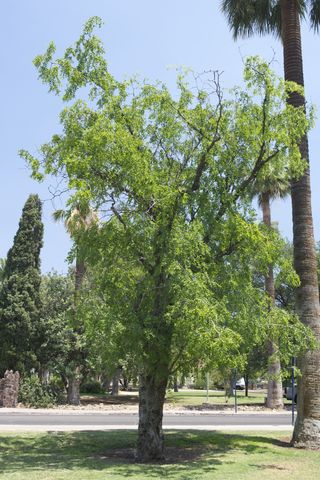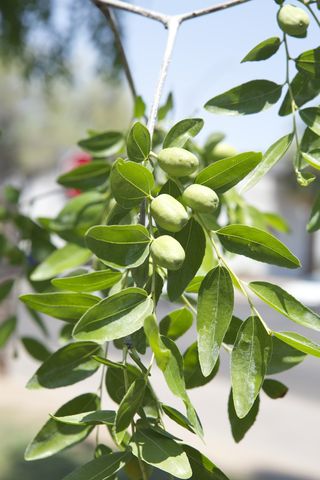 The Chinese Jujube - October 24, 2018 Jeff Schalau, Agent, Agriculture & Natural Resources University of Arizona Cooperative Extension, Yavapai County Given the increasing interest in growing new and interesting fruit crops, let’s have a look at the Chinese Jujube (Ziziphus jujuba). This deciduous, fruit-bearing tree can grow to about 40 feet tall, has shiny foliage, flaky, light gray bark, and an upright trunk with pendulous branches. These trees are not common anywhere in Arizona, but every once in a while, you may find one. A specimen is planted in the University of Arizona Campus Arboretum (see link on the online edition). I have also seen them in the Verde Valley and Peeples Valley in western Yavapai County. In summer, you may see them covered with small, shiny, edible fruits. Also known as the Chinese date, the Chinese jujube is a member of the Buckthorn family (Rhamnaceae) which makes it a distant relative of the Ceanothus: a genera of native shrubs. It has been cultivated for over 4,000 years in China. Seedlings were introduced to the U.S. in 1837 but cultivars were not introduced until 1908. Eighty-three varieties were introduced by 1914. They were never widely planted in orchards even though over 400 cultivars have been selected for cultivation. Chinese jujubes are deciduous and can tolerate cold winters to -28 degrees F. They have a low chilling requirement allowing them to produce fruit in areas having mild winters. Long, hot summers are necessary to ripen fruit crops. Flowers are small, approximately, 1/5 inch diameter, white, somewhat fragrant, and produced in large numbers in leaf axils. The flowering period extends over several months from late spring into summer. Most jujube cultivars produce some fruit without cross pollination, but yields are much higher when two or more different cultivars are planted together. Pollination is done by bees and flies. The fruit varies from almost perfectly round to elongated and from cherry-size to plum-size depending on cultivar. It has a thin, edible skin surrounding whitish sweet flesh. The single hard stone contains two seeds. The immature fruit is green in color, but mahogany-colored spots appear on the skin as the fruit ripens, and the fully mature fruit is entirely brown. Shortly after becoming fully brown, the crisp fruit begins to soften and wrinkle. The fruit can be eaten after it becomes wrinkled, but most people prefer them during the 3-5 day interval between the first appearance of the brown color and the time when wrinkling begins. The crop does not ripen simultaneously, and fruit can be picked for several weeks from a single tree. Jujubes tolerate many types of soils, but prefer sandy, well-drained soils. They are also able to grow in soils with high salinity or high alkalinity. Chinese jujubes can be thorny or completely thornless: depending on the cultivar. They can also produce suckers originating from adventitious buds on the roots (or rootstock in grafted plants). Although the Chinese jujube tree will tolerate drought, regular irrigation is necessary to assure a quality fruit crop. Fertilizer requirements have not been studied, but jujubes appear to do well with little or no fertilization. The Chinese jujube appears to have no serious disease, insect, or nematode pests in the U.S. The University of California, Davis has indicated that they are susceptible to decay causing fungi if physically damaged. As mentioned previously, Chinese jujube trees are not widely available. Seedlings will have varying fruit qualities and should be grafted for fruit production. Varieties “Li” and “Lang” may be the most readily available, but interest is increasing and more varieties should become commercially available. The Dave Wilson nursery propagates them in California and some local nurseries order bareroot fruit trees from this vendor. They may also be available at specialty nurseries in Tucson or Phoenix. Chinese jujube has some ethnobotanical uses. The first record of this plant being used as something other than a fruit was about 3,000 years ago in China. The dried kernel of the Chinese jujube was found to be a good sedative/hypnotic in the treatment of insomnia and neurasthenia. The plant is also used in many cultures to make a tea for sore throats. If you like unusual tree fruits and have some extra space, seek out the Chinese jujube. See photos and links to additional information below. Follow the Backyard Gardener on Twitter – use the link on the BYG website. If you have other gardening questions, call the Master Gardener help line in the Camp Verde office at 928-554-8992 or e-mail us at verdevalleymg@gmail.com and be sure to include your name, address and phone number. Find past Backyard Gardener columns or provide feedback at the Backyard Gardener web site: http://cals.arizona.edu/yavapai/anr/hort/byg/. Photos  Chinese jujube (Ziziphus jujuba) tree on the University of Arizona Campus, Tucson, Arizona (https://apps.cals.arizona.edu/arboretum/taxon.aspx?id=305).
Chinese jujube (Ziziphus jujuba) tree on the University of Arizona Campus, Tucson, Arizona (https://apps.cals.arizona.edu/arboretum/taxon.aspx?id=305). Chinese jujube (Ziziphus jujuba) showing unripe fruit on the University of Arizona Campus, Tucson, Arizona (https://apps.cals.arizona.edu/arboretum/taxon.aspx?id=305).
Chinese jujube (Ziziphus jujuba) showing unripe fruit on the University of Arizona Campus, Tucson, Arizona (https://apps.cals.arizona.edu/arboretum/taxon.aspx?id=305).Additional Resources Jujube: Chinese Date in New Mexico New Mexico State University Extension aces.nmsu.edu/pubs/_h/H330/ Jujubes Texas A & M AgriLife Extension aggie-horticulture.tamu.edu/extension/fruit/Jujube/jujube.html |